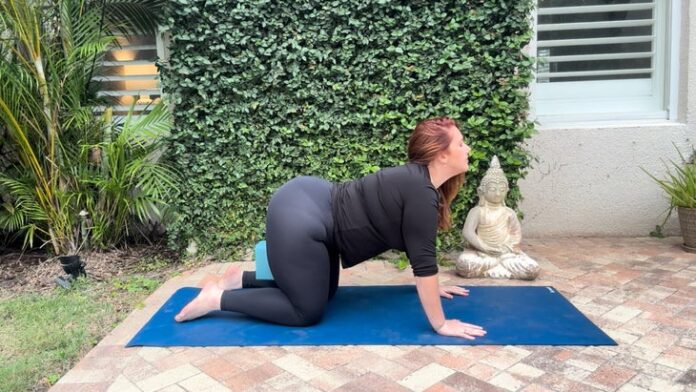“], “filter”: { “nextExceptions”: “img, blockquote, div”, “nextContainsExceptions”: “img, blockquote, a.btn, a.o-button”} }”>
Heading out the door? Read this article on the new Outside+ app available now on iOS devices for members!
>”,”name”:”in-content-cta”,”type”:”link”}}”>Download the app.
It’s estimated that more than 30 percent of women and 16 percent of men in the U.S. are affected by pelvic floor disorders. Your pelvic floor health is an essential component of overall body functioning—and not just among people who have had children. Unfortunately, it’s relatively easy for the complicated muscular relationship in the pelvic floor to become imbalanced through injury, illness, surgery, pregnancy, even habitual patterns such as the way you sit, stand, and walk.
Research on pelvic floor dysfunction correlates issues with this area not just your likelihood of urinary incontinence but also balance issues, spinal alignment and back pain, shoulder issues, and other silent symptoms. Since many of us aren’t conscious of our pelvic floor muscles, it can take something such as severe back pain or urinary incontinence to bring our attention to this part of our body.
But there are simple exercises that help strengthen and relax these muscles, as well as others, in support of pelvic floor health.
Anatomy of Your Pelvic Floor
There are four primary muscles responsible for the functioning of the pelvic floor— the pubococcygeus, iliococcygeus, coccygeus, and puborectalis. There are also supporting muscles in the hips and inner thighs. As with everything in the body, these muscles are in continual relationship with one another.
Because the pelvic floor is in a synchronous relationship with the rest of the body, practicing yoga poses and other movements that strengthen the feet, legs, and core also benefit the pelvic floor health.
Pelvic Floor Health and the Subtle Body
Similarly, accessing the muscles of the pelvic floor can have other related repercussions, including the release of deep-seated emotions that are contained within the body. That belief is behind the saying “the issues in the tissues” which is supported by research from trauma researcher Bessel van der Kolk contained in The Body Keeps the Score.
All experiences are valid. If any emotions or thoughts arise, acknowledge the situation and bring some compassion to it as you process. By working this area of the body you can offer physical and emotional support for all of the physical and energetic structures above, setting a firm and stable foundation for physical and emotional growth.
5 Exercises for Pelvic Floor Health
The following exercises deliver different ways to help support pelvic floor health.
1. Cat and Cow
The muscles that cross the hips also affect the pelvic floor health and function. Taking the following movement slowly and in sync with your breath can enhance your awareness of the pelvic floor muscles.
How to: Start on your hands and knees with your shoulders over your wrists and your hips above your knees. Place a yoga block between your mid-thighs and grip it slightly with the thigh muscles to hold it in place. Try not to squeeze your glutes. Instead, focus on the rotation of the thighs and the relaxing of your pelvic floor. As you inhale, feel your belly lower toward the floor as you inwardly rotate your thighs in Cow Pose. As you do this movement, rotate the thighs inward to move the block toward the wall behind you.
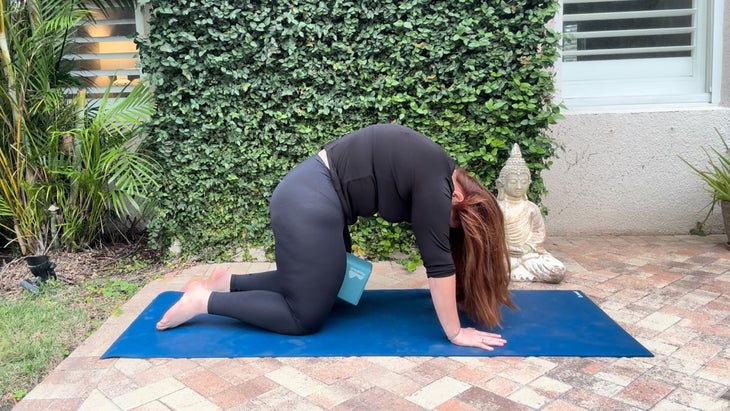
As you exhale, draw your navel toward your spine and arch your back into Cat Pose as your thighs externally rotate. Feel the center of the pelvic floor lift and the sitting bones draw toward one another as the block nudges forward in the direction of your nose.
Practice this for 5-10 repetitions.
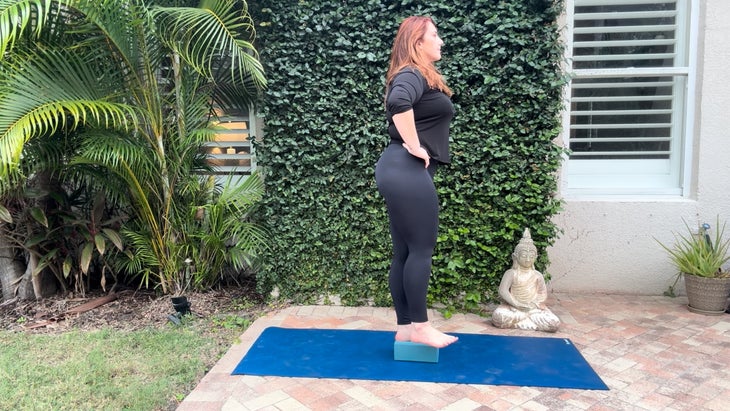
2. Standing Balancing Exercise
Studies indicate that there is a connection between reduced pelvic floor function and decreased balance. That means it can make a tremendous difference to strengthen the primary balancing muscles, such as the gluteus medius muscle, which crosses from the outer thigh bone to the upper pelvic area. Try balancing poses such as Tree Pose, Warrior 3, and this exercise.
How to: Stand one foot on a stair or a flat yoga block placed about a foot from a wall. Face the wall. You can rest one hand against the wall for support. Let your other leg hang off of the stair or block with your foot flexed.
Without bending your knees, lift the hip of your hanging leg as high as you can, tilting your pelvis to one side. Keep your standing leg still and straight and your abdominal muscles pulled inward to protect your back.
Then lower that same hip toward the floor, tilting the pelvis in the opposite direction. Repeat for 5-10 rounds. You can also explore making hip circles, forward and backward, to address all the fibers in the gluteus medius. Repeat on the other side.
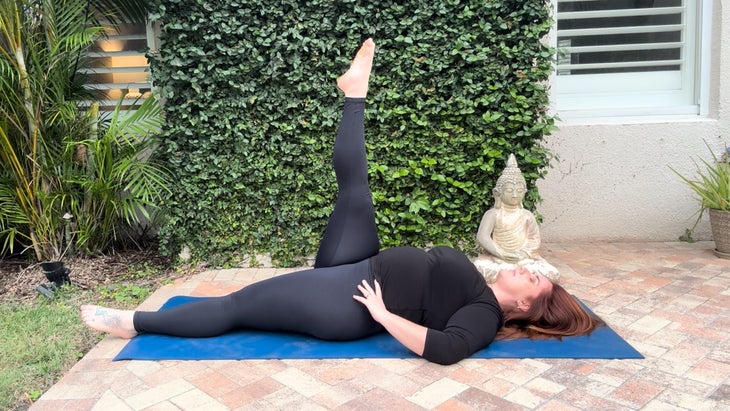
3. Reclined Leg Circles
In yoga, as well as in life, the slower you go, the more you feel. Practicing this exercise at a slower pace helps isolate and strengthen the smaller, lesser-used muscles in the pelvic floor.
How to: Come onto your back and reach your right leg straight toward the ceiling as if you were coming into a Reclining Hand-to-Big-Toe Pose.The other leg can rest straight on the floor or, if that’s uncomfortable, bend your knee and place your foot on the floor as you would in Bridge Pose.
Keep drawing your belly toward your spine as you point your right toes toward the ceiling and begin making teeny circles with your entire thigh, as if you were drawing on the ceiling with your big toe.
Begin to slowly expand those circles into slightly larger spirals, remembering to move as slowly as possible and keep your pelvis stable.
After you’ve spiraled the leg out as far as you can comfortably without moving or tilting your pelvis, slowly begin to spiral back inward toward center in the opposite direction. The goal is to move slowly and mindfully to access the deep muscles of the pelvic floor and hips, so take your time. Repeat on the other side.

4. Reclined Butterflies
It’s important to note that our bodies are meant to exist in a state of balance. Too much tension is not good but neither is too much stretching. We create further problems for ourselves when we do too much of anything. For example, engaging the mula bandha can be helpful, although you wouldn’t engage it constantly, either on the mat or off it. Finding the balance between strength and relaxation in the pelvic floor is key.
This exercise finishes with complete relaxation of the pelvic floor to avoid overtaxing these important and underused muscles.
How to: Lying on your back, bend your knees and rest your feet flat on the floor as you would in Bridge Pose. Inhale as you squeeze your thighs together. As you do this, feel the inhalation travel toward the base of your pelvis, feel your pelvic floor muscles relax, and imagine your sitting bones spreading apart.
Exhale as you lower your knees out to the sides into Reclining Bound Angle Pose or Butterfly. As you do this, feel the pelvic floor lift toward your chest as the sitting bones move toward each other.
Then repeat by squeezing your legs together again. After 5-10 rounds, linger with your knees open and rest in the passive stretch for a few breaths, letting your pelvic floor completely relax and returning to your natural rhythm of breathing

5. Mula Bandha Activation
Engaging the deep muscles of the pelvic floor is not easy. In yoga, we refer to this subtle contraction as mula bandha, meaning “root lock.” This engagement serves many purposes, both physical and energetic. Along with offering support to your core in postures such as inversions and arm balances, mula bandha is also said to lift the impurities of our energetic body toward the “fire” of our solar plexus chakra, or manipura, where they can be dissolved.
There is a misconception that performing a “kegel,” or squeezing the lower body muscles forcefully, is the same as engaging your mula bandha. But in many cases, people are unable to discern the correct muscles and end up squeezing their glutes instead.
The intended action is subtle and refined and takes practice to accessing muscles we often don’t even realize are there, let alone know how to contract consciously.
To learn how to engage the pelvic floor, we can begin by noticing a physiological process that’s already happening every day. The respiratory diaphragm and pelvic floor have a synergistic relationship. Each time you inhale, both of these “floors” move downward. When you exhale, they spring upward together.
To better understand how to lift the subtle pelvic floor muscles and experience this engagement, try the following exercise, which helps you feel this natural movement and slightly exaggerate it to strengthen your pelvic floor muscles.
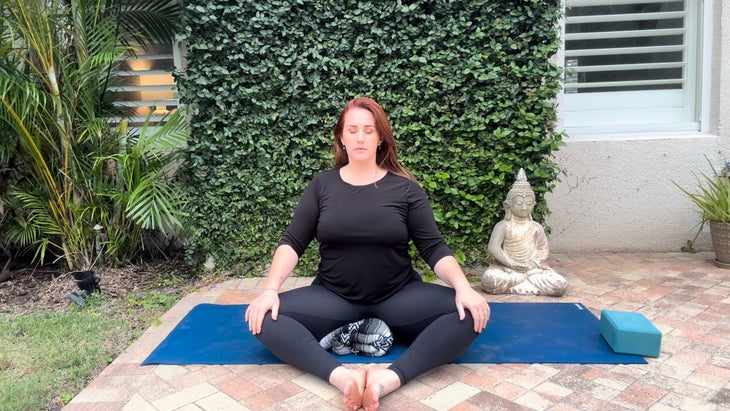
How to: Roll a yoga blanket or towel. The smaller the roll, the less pressure you will feel. Go with what’s most comfortable for you.
Sit cross-legged or in Bound Angle or Butterfly on the blanket with it positioned lengthwise between your sitting bones and pressing up against the perineum area. No, it’s not the most comfortable situation, but it will help you directly feel the muscles you’re trying to contract.
As you inhale, feel your lungs expand and press your abdomen downward. Your pelvic floor will naturally relax and press down into the blanket.
As you exhale, imagine lifting the center of your pelvic floor muscles away from the blanket. Do not tighten your glutes or lift your body off the blanket. You may not feel the pelvic floor actually leave the blanket but the intention of initiating lifting will help engage the correct muscles. This is a very subtle action in the perineum. Practice this for 3-5 minutes.


